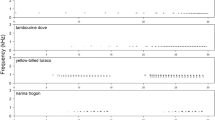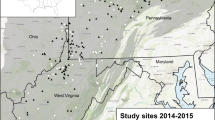Abstract
We investigated the main environmental variables determining the occurrence of the Eurasian Treecreeper Certhia familiaris and Short-toed Treecreeper C. brachydactyla within the mountain range of the Pyrenees. Presence/absence data were obtained, using the response to the playback of each species’ typical song; they were collected during the springs of 2004–2012 over 487 sites, within 33 areas of mature forest distributed over the mountain range. The analysis, based upon generalised linear models, showed that altitude, forest type, location within the mountain range and the presence of the sibling species influenced the occurrence of both treecreepers. Probability of occurrence of the Eurasian Treecreeper increased with altitude except in mountain pine forest, whereas at a given altitude it was lower in Scots pines than in other forest types. In the Short-toed Treecreeper, whose probability of occurrence was enhanced in oak forest, the altitude had a negative influence except in mountain pine forest. In the Eurasian Treecreeper, all other things being equal, probability of occurrence was higher in the forested areas experiencing an oceanic climate than those experiencing a Mediterranean-continental climate. The opposite was found in the Short-toed Treecreeper, whose probability of occurrence on the Pyrenees’ southern slope increased from the western to the eastern end of the mountain range. Finally, the presence of the sibling species decreased the probability of occurrence of both treecreepers at low and medium altitude, suggesting a restricted form of interspecific competition.
Zusammenfassung
Einflussfaktoren auf die Verbreitung der Baumläufer-Zwillingsarten Certhia familiaris und C. brachydactyla in den Pyrenäen
Wir untersuchten die wichtigsten Umweltvariablen, die das Vorkommen von Waldbaumläufern Certhia familiaris und Gartenbaumläufern C. brachydactyla entlang der Gebirgskette der Pyrenäen beeinflussen. Dazu wurden Präsenz/Absenz-Daten mit Hilfe von arttypischen Klangattrappen gewonnen. Diese Daten wurden vom Frühjahr 2004 bis 2012 an 487 Standorten innerhalb von 33 Gebieten mit ausgewachsenen Waldbeständen entlang der Gebirgskette gesammelt. Die auf generalisierten linearen Modellen basierende Analyse zeigte, dass die Höhenlage, der Waldtyp, die Lage entlang der Gebirgskette und die Präsenz der Zwillingsart das Vorkommen der beiden Baumläuferarten beeinflusste. Die Vorkommenswahrscheinlichkeit des Waldbaumläufers stieg, mit einer Ausnahme in Bergnadelwäldern, mit zunehmender Höhe an. Bei gleicher Höhenlage war hingegen die Vorkommenswahrscheinlichkeit in Waldkieferwäldern geringer als in anderen Waldtypen. Beim Gartenbaumläufer, dessen Vorkommenswahrscheinlichkeit in Eichenwäldern erhöht war, hatte die Höhenlage einen negativen Einfluss auf das Vorkommen außer in Bergnadelwäldern. Bei ansonsten gleichen Bedingungen zeigten die Waldbaumläufer eine höhere Vorkommenswahrscheinlichkeit in Waldgebieten mit ozeanischem Klima als in solchen mit kontinentalem Mittelmeerklima. Das Gegenteil wurde für den Gartenbaumläufer gefunden, dessen Vorkommenswahrscheinlichkeit an der Südseite der Pyrenäen vom westlichen bis zum östlichen Ende der Gebirgskette anstieg. Schließlich konnten wir feststellen, dass die Präsenz der Zwillingsart die Vorkommenswahrscheinlichkeit beider Baumläuferarten in niedrigen und mittleren Höhenlagen reduzierte. Dies lässt daher eher eine eingeschränkte interspezifische Konkurrenz vermuten.





Similar content being viewed by others
References
Affre G, Affre L (1980) Distribution altitudinale des oiseaux dans l’Est des Pyrénées françaises. Oiseau RFO 50:1–22
Anderson DR (2008) Model based inference in the life sciences: a primer on evidence. Springer, New York
Bartoń K (2016) MuMIn: multi-model inference. R package ver. 1.15.6. https://cran.r-project.org/web/packages/MuMIn/
Burnham KP, Anderson DR (2002) Model selection and inference. A practical information-theoretic approach, 2nd edn. Springer-Verlag, New York
Clouet M, Joachim J (2010) La répartition des deux espèces de grimpereaux Certhia familiaris et C. brachydactyla dans les Pyrénées. Alauda 78:137–148
Cramp S, Perrins CM (eds) (1993) The birds of the western Palearctic, vol VII. Oxford University Press, Oxford
Dhondt AA (2012) Interspecific competition in birds. Oxford University Press, Oxford
Dupias G (1985) Végétation des Pyrénées. Notice détaillée des cartes de végétation. CNRS, Paris
Freeman BG, Montgomery G (2016) Interspecific aggression by the Swainson’s Thrush (Catharus ustulatus) may limit the distribution of the threatened Bicknell’s Thrush (Catharus bicknelli) in the Adirondack Mountains. Condor 118:169–178
Freeman BG, Class Freeman AM, Hochachka W (2016) Asymmetric interspecific aggression in New Guinean songbirds that replace one another along an elevational gradient. Ibis 158:726–737
Frühauf J (1993) Treecreeper species with highly overlapping niches do not show interference competition. Abstracts of the XXIII International Ethological Conference, Torremolinos, Spain, p 245
Génard M, Lescourret F (1985) Caractérisation de l’avifaune d’une pinède de Cerdagne (Pyrénées Orientales): comparaison avec d’autres forêts de montagne. Oiseau RFO 55:277–290
Gil D (1997) Increased response of the short-toed treecreeper Certhia brachydactyla in sympatry to the playback of the song of the common treecreeper C. familiaris. Ethology 103:623–641
Huntley B, Green RE, Collingham YC, Willis SG (2007) A climatic atlas of European breeding birds. Durham University, The RSPB and Lynx Edicions, Barcelona
Hutchinson GE (1957) Concluding remarks. Cold Spring Harb Symp Quant Biol 22:415–427
Izard M, Casanova H, Devau B, Pautou G (1985) Continentalité et notion de zone interne dans les Pyrénées. Acta Oecologica 6:317–344
Jankowski JE, Robinson SK, Levey DJ (2010) Squeezed at the top: interspecific aggression may constrain elevational ranges in tropical birds. Ecology 91:1877–1884
Joachim J, Clouet M, Bousquet JF, Fauré C (1991) Peuplement d’oiseaux nicheurs des forets pyrénéennes centrales. Comparaison du peuplement des différentes essences. Acta Biologica Montana 10:135–157
Laurent JL (1987) Utilisation de l’espace par deux espèces jumelles Certhia brachydactyla et familiaris en zone de sympatrie. Rev Ecol (Terre Vie) 42:297–309
Lebreton P, Thévenot M (2009) Comparaison de l’avifaune de sapinières et de pinèdes médio-européennes et méditerranéennes. Rev Ecol (Terre Vie) 64:171–188
Métailié JP (1986) Les chênaies des montagnes pyrénéo-cantabriques, un élément forestier du système agropastoral. Rev Geo Pyr Sud-Ouest 57:313–324
Noon BR (1981) The distribution of an avian guild along a temperate elevational gradient: the importance and expression of competition. Ecol Monogr 51:105–124
Osiejuk TS (1998) Correlates of creeping speed variability in two species of treecreepers. Condor 100:174–177
Osiejuk TS, Kuczynski L (2000) Song functions and territoriality in Eurasian treecreeper Certhia familiaris and short-toed treecreeper Certhia brachydactyla. Acta Ornithol 35:109–116
Pearson RG, Dawson TP (2003) Predicting the impacts of climate change on the distribution of species: are bioclimate envelope models useful? Glob Ecol Biogeogr 12:361–371
Peiman KS, Robinson BW (2010) Ecology and evolution of resource-related heterospecific aggression. Q Rev Biol 85:133–158
Peterson AT, Soberon J, Sanchez-Cordero V (1999) Conservatism of ecological niches in evolutionary time. Science 285:1265–1267
Pons JM, Thibault JC, Fournier J, Olioso G, Rakovic M, Tellini Florenzano G, Fuchs J (2015) Genetic variation among Corsican and continental populations of the Eurasian treecreeper (Aves: Certhia familiaris) reveals the existence of a palaeoendemic mitochondrial lineage. Biol J Linn Soc 115:134–153
Prodon R, Thibault JC, Dejaifve PA (2002) Expansion vs Compression of bird altitudinal ranges on a Mediterranean island: interaction of climate and history. Ecology 83:1294–1306
Purroy FJ (1973) La répartition des deux grimpereaux dans les Pyrénées. Oiseau RFO. 43:205–211
R Core Team (2015) R: a language and environment for statistical computing. R foundation for statistical computing, Vienna, Austria. http://www.R-project.org/
Roché JC, Pulce P, Nicolle S, Munier V, Lemmel C (2004) Le chant des oiseaux. CDrom, Sittelle, Paris
Schepers F (1997) Certhia brachydactyla short-toed treecreeper. In: Hagemeijer WJM, Blair MJ (eds) The EBCC atlas of European breeding birds. Poyser, London
Schepers F, Török J (1997) Certhia familiaris treecreeper. In: Hagemeijer WJM, Blair MJ (eds) The EBCC atlas of European breeding birds. Poyser, London
Schnebel G (1972) Die Ökologie der Baumläufer (Certhia brachydactyla) und (Certhia familiaris) in Ostniedersachsen. Vogelwelt 93:201–215
Terborgh J, Weske JS (1975) The role of competition in the distribution of Andean birds. Ecology 56:562–576
Tietze DT, Martens J (2009) Morphometric characterisation of treecreepers (genus Certhia). J Ornithol 150:431–457
Tietze DT, Martens J, Sun Y-H (2006) Molecular phylogeny of treecreepers (Certhia) detects hidden diversity. Ibis 148:477–488
Tietze DT, Martens J, Sun Y-H, Päckert M (2008) Evolutionary history of treecreeper vocalisations (Aves: Certhia). Org Divers Evol 8:305–324
Wiens JA (1977) Competition and variable environments. Am Sci 65:590–597
Zink RM (2014) Homage to Hutchinson, and the role of ecology in lineage divergence and speciation. J Biogeogr 41:999–1006
Acknowledgements
We gratefully thank Michel Goulard for his advice on the statistical procedures, Jean-Marc Pons for his comments of the manuscript, Sian Forster for checking the English language and two anonymous reviewers for their comments and suggestions.
Funding
The authors received no funding for this work.
Author information
Authors and Affiliations
Corresponding author
Ethics declarations
Conflict of interest
The authors declare that they have no conflict of interest.
Additional information
Communicated by T. Gottschalk.
Rights and permissions
About this article
Cite this article
Clouet, M., Gerard, JF. Factors affecting the distribution of the sibling species of treecreepers Certhia familiaris and C. brachydactyla in the Pyrenees. J Ornithol 160, 27–36 (2019). https://doi.org/10.1007/s10336-018-1605-5
Received:
Revised:
Accepted:
Published:
Issue Date:
DOI: https://doi.org/10.1007/s10336-018-1605-5




